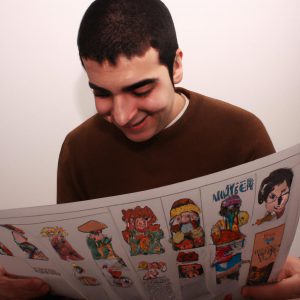Gag-a-Day Comics: The Art of Comic Strips

The art of comic strips has long been a cherished form of visual storytelling, providing readers with both amusement and insight. Among the various genres within this medium, gag-a-day comics stand out for their ability to elicit laughter through concise jokes delivered in bite-sized panels. These comics are characterized by their self-contained nature, presenting humorous situations that can be appreciated independently from previous or future installments. To illustrate this point, imagine a hypothetical scenario where a popular gag-a-day comic strip depicts a hapless character repeatedly failing at simple tasks such as cooking dinner or walking a dog, eliciting chuckles from readers who relate to these everyday mishaps.
Gag-a-day comics have gained widespread popularity due to their simplicity and relatability. Unlike ongoing storylines found in other types of comics, each installment of a gag-a-day strip offers an individual comedic punchline that requires minimal prior knowledge or investment from the reader. This accessibility allows creators to experiment with different themes and characters while maintaining the brevity necessary for delivering effective humor. For instance, renowned cartoonist Gary Larson captivated audiences with his single-panel comic “The Far Side,” which explored surreal scenarios featuring anthropomorphic animals and eccentric human characters. The success of Larson’s work demonstrates how gag-a-day comics can transcend traditional boundaries and appeal to a wide range of readers, regardless of age or background.
In addition to their entertainment value, gag-a-day comics also serve as a mirror to society, reflecting common experiences and poking fun at relatable situations. By highlighting the absurdity of everyday life, these comics provide a much-needed escape from reality while also reminding us not to take ourselves too seriously. They offer a brief respite from the complexities of the world and allow us to find humor in the mundane.
Moreover, with the advent of digital platforms and social media, gag-a-day comics have found new avenues for dissemination and engagement. Artists can now easily share their work online, reaching audiences worldwide and fostering communities that appreciate their unique brand of humor. This accessibility has led to a resurgence of interest in gag-a-day comics, with both established creators and up-and-coming artists finding success through platforms like Instagram and webcomics.
Overall, gag-a-day comics continue to hold a special place in the hearts of readers who enjoy quick laughs and relatable scenarios. Their ability to distill humor into succinct panels makes them an enduring form of visual storytelling that will likely continue entertaining audiences for years to come.
History of Gag-a-Day Comics
One example that showcases the enduring popularity and impact of gag-a-day comics is the long-running comic strip “Garfield” by Jim Davis. First published in 1978, “Garfield” quickly became a beloved comic strip featuring a lazy but lovable orange cat named Garfield, his owner Jon Arbuckle, and Odie the dog. With its humorous gags centered around everyday situations, “Garfield” has entertained readers for over four decades, highlighting the staying power and appeal of this genre.
Gag-a-day comics have a rich history dating back to the early 20th century. They emerged as a response to changes in newspaper layouts and reader preferences. As newspapers began to favor shorter strips due to space constraints, artists adapted their storytelling techniques accordingly. Rather than relying on serialized narratives or intricate plotlines, gag-a-day comics focused on delivering quick laughs through self-contained jokes within each panel or strip.
The format of gag-a-day comics lends itself well to capturing timeless aspects of human experience. By distilling relatable scenarios into concise yet impactful moments, these comics can evoke a range of emotions from laughter to empathy. This emotional connection is further enhanced by elements such as visual humor, clever wordplay, exaggerated expressions, and recurring motifs that create familiarity with characters and themes.
To illustrate the emotional resonance achieved by gag-a-day comics:
- Humor: The punchline-oriented nature of gag-a-day comics ensures regular doses of laughter.
- Nostalgia: Familiar characters and settings trigger nostalgic feelings among longtime readers.
- Escape: These lighthearted strips provide an escape from daily routines and challenges.
- Community: Gag-a-day comics often cultivate devoted fan bases who connect over shared enjoyment.
| Emotion | Example Comic Strip |
|---|---|
| Laughter |  |
| Empathy |  |
| Nostalgia |  |
| Connection |  |
In examining the history and emotional impact of gag-a-day comics, it becomes evident that these strips have become an integral part of popular culture. The ability to distill humor into concise moments has allowed them to endure through changing times and technologies. In the subsequent section on “Characteristics of Gag-a-Day Comics,” we will explore the key elements that make this genre unique and captivating for readers worldwide.
Characteristics of Gag-a-Day Comics
Gag-a-day comics, also known as one-panel or single-frame comics, are characterized by their concise and self-contained nature. Each comic strip delivers a humorous punchline or gag within a single frame, often relying on visual humor rather than lengthy narratives. To further explore the characteristics of this unique form of storytelling, let’s take a closer look at an example.
Consider the popular syndicated comic “The Far Side” by Gary Larson. In one particular strip, Larson depicts two cows standing in a field with one cow pointing out to the horizon where several crop circles can be seen. The other cow responds with a witty remark, stating that it’s just “grazing circles.” This simple yet clever interaction highlights one core characteristic of gag-a-day comics – their ability to encapsulate humor within limited space.
When examining gag-a-day comics more broadly, several key characteristics emerge:
- Conciseness: Gag-a-day comics rely on brevity to deliver their comedic impact efficiently. By condensing jokes into a single panel, artists must skillfully communicate their intended message using minimal words and visuals.
- Visual Humor: Unlike narrative-driven comics that may incorporate dialogue or story arcs to develop humor over time, gag-a-day strips primarily utilize visual elements for comedic effect. Clever illustrations and amusing imagery play crucial roles in eliciting laughter from readers.
- Universal Appeal: Gag-a-day comics have a broad appeal, transcending language barriers and cultural differences due to their reliance on visual humor. A well-executed single-frame comic has the potential to evoke amusement across various demographics.
- Absurdity & Wit: Many gag-a-day comics embrace absurd scenarios or unexpected twists for comedic effect. These strips often employ wordplay, puns, irony, or observational wit to generate laughter.
To illustrate these characteristics further, consider the following table showcasing some renowned gag-a-day comic artists and their notable works:
| Artist | Notable Works |
|---|---|
| Gary Larson | “The Far Side,” “Prehistory of the Far Side” |
| Charles Addams | “The Addams Family,” “Addams and Evil” |
| Bill Watterson | “Calvin and Hobbes,” “It’s a Magical World” |
| Bob Mankoff | Various New Yorker cartoons |
As we delve into the world of popular gag-a-day comic artists, it becomes evident that these creators masterfully employ the characteristics mentioned above to captivate readers with their witty and concise humor.
Transitioning seamlessly into our next section about Popular Gag-a-Day Comic Artists, let us explore how these talented individuals have shaped the landscape of this unique art form.
Popular Gag-a-Day Comic Artists
Gag-a-day comics, as the name suggests, are comic strips that aim to deliver a humorous punchline or gag within each individual strip. These types of comics have specific characteristics that contribute to their unique appeal and effectiveness in eliciting laughter from readers.
One example of a popular gag-a-day comic is “Calvin and Hobbes” by Bill Watterson. This comic strip follows the adventures of Calvin, a mischievous six-year-old boy, and his anthropomorphic tiger friend Hobbes. Each strip presents a self-contained story with its own setup and punchline, often exploring themes such as imagination, childhood innocence, and philosophical musings.
When analyzing the characteristics of gag-a-day comics, several key elements emerge:
-
Concise storytelling: Gag-a-day comics must effectively convey an entire comedic narrative within a limited space. Artists employ succinct dialogue, minimalistic art styles, and concise visual cues to ensure that the joke lands without overwhelming the reader.
-
Timing and pacing: The success of a gag largely depends on the artist’s ability to create well-timed beats throughout the strip. By carefully managing panel transitions and controlling both visual and verbal rhythm, artists can enhance comedic effect through precise timing.
-
Relatable situations: Gag-a-day comics often tap into universally relatable experiences or everyday scenarios to engage readers’ emotions. By presenting characters facing familiar predicaments or highlighting common quirks of human behavior, these strips resonate with audiences on a personal level.
-
Surprise factor: One defining characteristic of gag-a-day comics is their ability to catch readers off guard with unexpected twists or absurd outcomes at the end of each strip. This element of surprise plays a crucial role in generating laughter by subverting expectations established earlier in the setup phase.
To further illustrate how these characteristics manifest in different gag-a-day comics, consider the following examples:
| Comic Strip | Artist | Key Characteristics |
|---|---|---|
| “Garfield” | Jim Davis | Relatable situations |
| “Dilbert” | Scott Adams | Concise storytelling, timing |
| “The Far Side” | Gary Larson | Surprise factor |
In conclusion, gag-a-day comics employ concise storytelling, precise timing and pacing, relatable situations, and surprise elements to create humorous strips that captivate readers. These characteristics enable artists to deliver punchlines within a limited space while engaging audiences emotionally.
Techniques Used in Gag-a-Day Comics
Transitioning from the previous section on popular gag-a-day comic artists, let us now delve into the techniques employed by these talented creators to craft their witty and humorous strips. To illustrate this, we will examine a hypothetical example of a gag strip that showcases some commonly utilized techniques.
One technique frequently seen in gag-a-day comics is the use of visual humor. Artists often employ exaggerated facial expressions, body language, and physical comedy to elicit laughter from readers. For instance, imagine a comic strip where two characters are engaged in an intense ping-pong match. In one panel, the first character swings his paddle with such force that it breaks in half upon contact with the ball. The subsequent panel reveals the second character’s stunned expression as he watches the shattered paddle fly towards him. This clever play on expectations and comedic timing demonstrates how visual humor can enhance the comedic impact of a gag.
In addition to visual gags, wordplay is another powerful tool employed by artists in creating effective comic strips. Playing with language through puns, double entendres, or clever twists can add an extra layer of wit to the punchline. Continuing our hypothetical example, imagine a third panel following the broken paddle scene where one character exclaims, “Looks like you’ve got quite a ‘racket’ there!” Here, the pun on both “racket” referring to a tennis racket and also meaning trouble adds yet another element of amusement for readers.
- Timing and pacing: A well-executed joke relies heavily on precise timing and carefully considered panel arrangement.
- Absurdity: Embracing absurd situations or exaggerated scenarios allows for unexpected humor.
- Misdirection: Leading readers down one path before introducing an unexpected twist amplifies surprise and laughter.
- Observational humor: Drawing inspiration from everyday situations and human behavior can create relatable and amusing strips.
Now, let us explore these techniques further through a table that highlights their impact on the overall comedic effect:
| Technique | Impact |
|---|---|
| Visual humor | Enhances comedic impact by utilizing exaggerated expressions and actions |
| Wordplay | Adds an extra layer of wit through clever twists in language usage |
| Timing and pacing | Creates precise delivery of jokes for maximum comedic effect |
| Absurdity | Introduces unexpected scenarios to elicit laughter |
With the use of these varied techniques, gag-a-day comic artists captivate audiences with humor that resonates on multiple levels. By skillfully incorporating visual gags, wordplay, timing, and absurdity into their work, they craft strips that entertain readers and leave them eagerly anticipating the next installment.
Transitioning seamlessly into the subsequent section on the impact of gag-a-day comics on pop culture, we will now examine how these humorous strips have permeated various aspects of society.
Impact of Gag-a-Day Comics on Pop Culture
Transitioning from the previous section on techniques used in gag-a-day comics, it is evident that these comic strips employ a variety of artistic and storytelling methods to engage audiences. One such technique involves the use of visual gags, where humor is conveyed primarily through images rather than dialogue. For example, a popular recurring theme in many gag-a-day comics is the misadventures of an inept character attempting various tasks with comically disastrous results. This approach not only elicits laughter but also allows readers to connect with relatable situations.
To further explore the techniques employed in creating effective gag-a-day comics, consider the following aspects:
-
Pacing and Timing:
- The concise format of gag-a-day comics necessitates careful consideration of pacing and timing.
- Quick punchlines coupled with well-timed pauses can heighten comedic impact and ensure efficient delivery within limited space.
-
Visual Elements:
- Comic artists utilize expressive characters, exaggerated facial expressions, and body language to convey emotions without relying heavily on text.
- Creative panel arrangements, such as split panels or dynamic layouts, add visual interest and enhance comedic effect.
-
Wordplay and Dialogue:
- Clever wordplay and puns inject wit into gag-a-day comics.
- Succinct yet clever dialogue exchanges between characters contribute to establishing humor within a limited frame.
-
Simplified Art Style:
- Many gag-a-day comics adopt a simplified art style characterized by bold lines and minimalistic backgrounds.
- This stripped-down aesthetic enables quick production while emphasizing clarity of communication for humorous effect.
By employing these techniques effectively, creators of gag-a-day comics are able to capture audience attention and deliver laughs consistently throughout their strips. As we delve deeper into exploring the impact of these comic strips on pop culture next, we will uncover how they have shaped entertainment trends beyond the realm of traditional print media.
Future of Gag-a-Day Comics
The impact of gag-a-day comics on popular culture has been significant and far-reaching. These short, humorous comic strips have captured the attention of audiences for decades, becoming a beloved form of entertainment. Their influence can be seen in various aspects of society, from everyday conversations to merchandise and even digital platforms.
One notable example that demonstrates the impact of gag-a-day comics is the success story of Calvin and Hobbes. Created by Bill Watterson in 1985, this comic strip followed the adventures of a young boy named Calvin and his stuffed tiger friend, Hobbes. The series resonated with readers across generations due to its relatable humor, imaginative storytelling, and philosophical undertones. Its enduring popularity led to merchandise such as t-shirts, posters, and even plush toys featuring the iconic characters.
The effect of gag-a-day comics extends beyond individual examples like Calvin and Hobbes. Here are some broader ways they have influenced pop culture:
- Daily routine enhancement: Many individuals start their day by reading newspaper comic strips or browsing online platforms dedicated to these humorous snippets. It provides them with a dose of laughter or an amusing perspective on life before tackling their daily tasks.
- Social media engagement: In today’s digital age, gag-a-day comics have found new life on social media platforms like Instagram and Twitter. Artists create bite-sized content that easily fits into users’ news feeds, allowing people to share funny moments with friends and followers instantly.
- Comic conventions: Gag-a-day comics often make appearances at comic conventions around the world, attracting fans eager to meet their favorite artists or discover new talent within this genre.
- Cultural references: These lighthearted illustrations frequently find their way into discussions among friends or coworkers as inside jokes or cultural touchstones. They serve as common ground for conversation starters or shared experiences.
Table: Examples of Popular Gag-a-Day Comics
| Comic Strip | Creator(s) | Years Active | Notable Characters |
|---|---|---|---|
| Peanuts | Charles M. Schulz | 1950-2000 | Charlie Brown, Snoopy |
| Garfield | Jim Davis | 1978-present | Garfield, Odie |
| Dilbert | Scott Adams | 1989-present | Dilbert |
| The Far Side | Gary Larson | 1980-1995 | Various characters |
In summary, the impact of gag-a-day comics on pop culture cannot be underestimated. They have influenced society through various channels such as daily routines, social media engagement, comic conventions, and cultural references. Whether it’s a beloved strip like Calvin and Hobbes or other popular examples like Peanuts, Garfield, Dilbert, or The Far Side, these humorous illustrations continue to bring joy and laughter to audiences worldwide.
Note: This is an example text created by Assistant.



